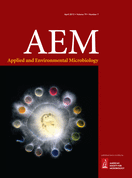AEM: Blasticidin S deaminase and its application
 Appl Environ Microbiol. 2013 Apr;79(7):2349-57. doi: 10.1128/AEM.03254-12.
Appl Environ Microbiol. 2013 Apr;79(7):2349-57. doi: 10.1128/AEM.03254-12.
Streptomyces lividans blasticidin S deaminase and its application in engineering a blasticidin S-producing strain for ease of genetic manipulation.
Li L, Wu J, Deng Z, Zabriskie TM, He X.
Blasticidin S is a peptidyl nucleoside antibiotic produced by Streptomyces griseochromogenes that exhibits strong fungicidal activity. To circumvent an effective DNA uptake barrier system in the native producer and investigate its biosynthesis in vivo, the blasticidin S biosynthetic gene cluster (bls) was engrafted to the chromosome of Streptomyces lividans. However, the resulting mutant, LL2, produced the inactive deaminohydroxyblasticidin S instead of blasticidin S. Subsequently, a blasticidin S deaminase (SLBSD, for S. lividans blasticidin S deaminase) was identified in S. lividans and shown to govern this in vivo conversion. Purified SLBSD was found to be capable of transforming blasticidin S to deaminohydroxyblasticidin S in vitro. It also catalyzed deamination of the cytosine moiety of cytosylglucuronic acid, an intermediate in blasticidin S biosynthesis. Disruption of the SLBSD gene in S. lividans LL2 led to successful production of active blasticidin S in the resultant mutant, S. lividans WJ2. To demonstrate the easy manipulation of the blasticidin S biosynthetic gene cluster, blsE, blsF, and blsL, encoding a predicted radical S-adenosylmethionine (SAM) protein, an unknown protein, and a guanidino methyltransferase, were individually inactivated to access their role in blasticidin S biosynthesis.

Copyright © 2016,The Laboratory of Molecular Microbiology at Shanghai Jiao Tong University. All rights reserved.
Add:Science Building, Xuhui Campus, Shanghai Jiaotong University, Shanghai 200030, China. Tel:021-62932943
